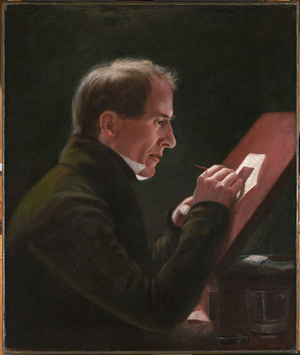
Image Credit: George Hollingsworth
Earliest source: "Alvan Clark (1804-1887)." Harvard Portrait/Clock Collections. Harvard Libraries, HUAM311226
Alvan Clark (1804-1887), who at the time of this portrait is a portrait painter himself (shown here painting), specializing in miniatures. He is also an engraver. In the early 1840s he and his sons Alvan Graham and George Basset Clark go into telescope making business as a part-time endeavor.
Sometime shortly after the Great Refractor is installed (1847), Alvan Clark has the opportunity to use the instrument. Based on his telescope-making experience so far, he sees subtle flaws. As the story goes, this experience, along with hearing how much money could be made selling large refractors ($12,000 for Harvard's lens or about $300,000 in 2015 dollars), motivates him to go into telescope-making full time, and take on more ambitious projects. By 1862, they build the largest refractor in the world (18.5"), originally commissioned for the University of Mississippi, but sold to the University of Chicago, due to the Civil War.
The Clarks would go on to make the world's largest refractor four more times, including the 36 inch Lick refractor, and finally the 40 inch Yerkes refractor, the largest working refractor ever built.
While the relationship with Harvard is fairly tangential (and geographic, as their business was located in Cambridge for years, see the map of 1877 below), this portrait is actually currently located at the Observatory. According to Harvard, it was a gift of Mrs. Alvan Clark [which one?] to the Harvard College Observatory in 1899 (Alvan died in 1887, Alvan G. died in 1897).
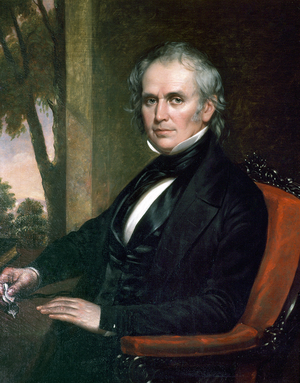
Image Credit: Cephas Thompson
Earliest source: "William Cranch Bond." Time and Navigation / The untold story of getting from here to there.. Smithsonian Institution, 19 [retrieved] August 2015.sibond
This is the earliest depiction I have of William Cranch Bond. Bond was a famous clockmaker, by virtue of being the son of a famous clockmaker. He was also keenly interested in astronomy from an early age. As a child, he used a telescope to observe a solar eclipse, apparently without supervision, and damaged his eyesight for a number of years.bondmemorials. His fascination with astronomy was such that in 1815, John Farrar, then the Hollis Professor of Mathematics and Natural Philosophy, asked him to visit observatories in Europe and report back. Apparently Bond's descriptions sounded too expensive, and no Observatory was built at tha time.heavensalarm
Evenutally though, the Observatory was created, and Harvard "hired" him as the first director of their new Observatory. Hiring did not involve any salary, but it did involve him transferring all of his own personal astronomical equipment to Harvard property. Not a bad deal for Harvard.
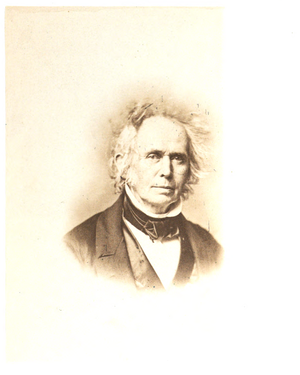
Earliest source: William Cranch Bond and George PHillips Bond [and Joseph Winlock]. Annals of the Astronomical Observatory of Harvard College / 1859-1860 vol. 7. Welch, Bigelow, & Co., 1872.annals7
A photo of William Cranch Bond. Bond died in 1859, while negative photography was still relatively new, but a negative of him must have existed in order to print this image, which is taken from the 1872 Annals.annals7 I'm unsure of the printing technology used here. At first I assumed it was a photolithograph, however no halftone screen is visible (although it could be a gravure method). This could also be a photo pasted into each copy, probably an albumen print, although I don't see all the edges if it's pasted - which could be a scan quality issue.
This is only the second image of him I'm aware of, the first being the painting above. All other images I've seeen are versions of one of these two original sources. The 1855 date given here is a fairly wild guess of when the photograph that it was based on was taken.
It's a fairly early example of a printed photograph, but not crazy early. Photographs in print didn't really become common until 1880s or especially 1890s, but photographs had been in print experimentally since about 1835, and to a limited degree in professional publishing since the early 1850s.
Crazy hair, right? I think some of the images derived from this original take a little artistic license, and make it even a bit more wild. I haven't had time to research his hair, but it's definitely an avenue of exploration. Was this fashionable? Unfashionable? Mad-scientist? Did people mention his hair in the published memorials of him? So many important questions remain.

Oh the irony.
The second director of the Observatory, taking over after his father's death in 1859, George Phillips Bond will serve as director for only six years, until his own death. He is considered the father of astrophotography, dedicating his short career to progress in this area. He and his father assisted John Whipple in his famous photographs of the moon, and it was George who brought them to Europe, where they were instantly famous. The heavily photographic programs of future directors Winlock and Pickering (with all the women computers doing the grunt work) will be built on foundations created by George Phillips Bond.
And despite all this, there are no known photographs of him at all, nor any portraits of any kind.
All we have is descriptions. His daughter Elizabeth offers hers:
"In person he was rather tall (a little under six feet) and slender, becoming, of later yearsm painfully thin. His hair was wavy and very dark, if not black; his complexion pale, and his eyes of the deepest blue, with a glowing spiritual light in them that transfigured the worn face, lending it a singular power and beauty quite apart from mere regularity of feature."bondmemorials
He was not the son destined to follow in his father's footsteps. His younger brother, William Cranch Bond Jr. was an avid astronmer and seen by some as the bright hope for the future of the Observatory. But he died at the end of his college career. Older brother George assumed the mantle of astronomy "with some reluctance" as a friend describes. George's first and greatest love was ornithology.bondmemorials
As if having no portraits isn't enough of a slight, it's also hard to find him now. Some online sources say he is buried at Mount Auburn Cemetery as is his father. But he's not in the Mount Auburn Database. So I had a look for myself. The family Bond monument has many names carved in it. George's name and other details are carved into the back, behind the bushes. But it turns out that many family names have been added to W. C. Bond's monument, though they are interred elsewhere. After contacting Mount Auburn Cemetery, they were able to tell me that George is interred in Cambridge Cemetery, lot 305.

Earliest source: F. O. Vaille and H. A. Clark (Class of 1874). The Harvard Book / A Series of Historical, Biographical, and Descriptive Sketches vol. 1. Welch, Bigelow, and Company, 1875.harvardbook
Joseph Winlock was the third director of the Harvard Observatory, taking over after George Phillips Bond passed away in 1865. Winlock would only serve a decade until his own death, around the time this book was published.
Winlock was the grandson of a revolutionary war soldier, General Joseph Winlock (starting as a private; Captain by the end of the war). Raised on a farm in Kentucky, he graduated from Shelby College, where he was given an appointment as professor of Mathematics and Astronomy. He moved from there to working as a computer in Cambridge for the American Ephemeris and Nautical Almanac. After several more job changes and advancements, he wound up at the Observtory, where he took over as director.academywinlock
Under Winlock, the Observatory sold accurate time data to various customers, in part based on improvements to the instruments made by Winlock. In appreciation for this, Harvard provided his family with a stipend of the proceeds from this service for five years. Perhaps it was not enough, or perhaps she just wanted to follow in her father's footsteps, because his daughter Anna felt the need to ask the Observatory for a job as a computer, and thus became the first woman hired for this work at the Observatory (as far as anyone knows), eventually joined by her sister Louisa.
I don't know when the photograph was taken, but given that all the photographs in the book seem to be in the same style, I think it's ok to assume they were all taken in preparation for this book, which was begun by the class of 1874 in their final year.harvardbook
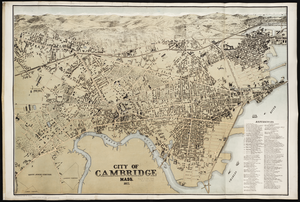
An 1877 map of Cambridge, notable because of all the hand drawn buildings of Cambridge. The Observatory is shown with both wings, with the Prime Vertical building to the north, and with the additional space completed to the North West. It also shows several smaller buildings to the west, but I believe these are houses off of Madison, as they don't correspond to the instruments that the Observatory had in place at the time. Substantial tree growth is shown in what was earlier mostly cleared fields. The Botanical Garden used Observatory space as a nursery at some point, although I'm not sure how much this contributed to the landscaping.
If you inspect the bottom right portion of the map, and follow the bridge up from the bottom, taking the left branch, this will put you on Brookline Steet. As you go up you will first cross Leverett St. and then come to Henry Street. There are several buildings drawn in below and to the right of Brookline and Henry. This is the Alvan Clark & Sons telescope company. For more details, see the 1840 portrait of Alvan Clark above.
The same year this map was made, Alvan Clark used a 26-inch telescope he'd made for the University of Virginia to confirm the discovery of Mars' moons, made by the other 26-inch telescope at the Naval Observatory, which Clark & Sons had delivered several years earlier.academy12 mechanic26
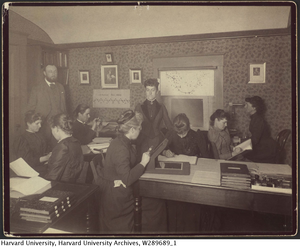
Earliest source: "[Observatory computer room and staff], 1891." Harvard University Archives / HUV 1210 (9-4). Harvard Libraries, olvwork289689
Nearly the identical photo as the previous, but with Pickering added standing on the left. Obviously taken the same day.
Note that the women did not work this closely. As can be seen in the above photos with Mrs. Draper, the room is larger and they are crowded together for sake of the photograph. There were between three and five rooms total for the computing work, and by my best guess about 15 women worked there at that time, as well as at least five men. Still cramped, but not this cramped.
The following year, a brick building was constructed to help out with the space issues.
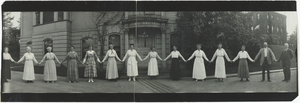
Earliest source: "[Observatory Staff in "paper doll" pose, (in line holding hands) panoramic photograph ca. 1918]." Harvard University Archives / UAV 630.271 (391). Harvard Libraries, olvwork432043
From left to right (primary identifications come from Harvard, who says the names were listed on the back):
I believe the correct names for two of these are "Mary H. Vann" and "Dorothy Block".jaavsoharwood Also, I think this is Mabel, not Edith Gill (or the few other labelled photos I've seen so far similarly mislabel the presumed sisters).
For the longest time I didn't know where pictures like this one were taken. This is an addition to the director's residence added in about 1893 that maybe doubled the size of the residence. The building is not curved, and the brick building to the right is the end of the astrophotographic addition, lying in the same plane. The wide angle just makes it look like a 90 degree bend.
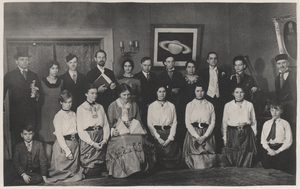
The Cast and Crew of the Observatory Pinafore
A set of six photos of the Observatory Pinfore has recently turned up. They've been scanned by their owner, Charles Reynes, who's the great grandson of Edward Skinner King (who was almost certainly at the performance - he's in the group photo for the AAS conference where the play was staged). They are by far the best quality images I've found anywhere of the performance, and three of them haven't been found anywhere else.
I'm having a particular problem with two identifications from these photographs: G. W. Wheelwright as Winslow Upton and W. R. Ransom as Pickering. I'm hoping to identify the characters from the context of the photos, but at this point I'm not sure that will work. From the opposite end, I've attempted to find photographs of both Wheelwright and Ransom in other contexts. Neither seems to look at all like the character in the photos with the more recessed chin.
Identifications:
Bart J. Bok, unknown women, unknown man, [Wheelwright or Ransom], unknown woman, Harlow Shapley, [Ransom or Wheelwright], Arville Walker, Peter M. Millman, Arthur R. Sayer, Leon Campbell
unknown boy, Mildred Shapley, Adelaide Ames, Cecilia Payne (Gaposchkin), Henrietta Swope, Sylvia Mussels (Lindsay), Helen Sawyer (Hogg), unknown boy
Use/Copyright: Copyright held by Charles Reynes, used here with permission
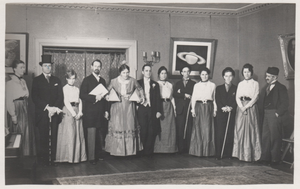
The cast of the Observatory Pinafore
Identifications:
Adelaide Ames (as Rhoda G. Saunders), Bart J. Bok (as Leonard Waldo), Mildred Shapley (as computer), Unknown, Cecilia Payne (as Josephina McCormack), Peter M. Millman (as William Augustus Rogers), Henrietta Swope (as computer), Unknown, Helen Sawyer (as computer), Arthur R. Sayer (as F. E. Seagrave), Sylvia Mussels (as computer), Leon Campbell (as Arthur Searle).
Use/Copyright: Copyright held by Charles Reynes, used here with permission
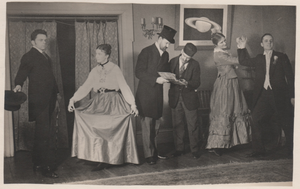
A scene from the Observatory Pinafore performance, perhaps dancing.
Identifications
Bart J. Bok, Adelaide Ames, Unknown, Leon Campbell, Cecilia Payne, Peter Millman
Use/Copyright: Copyright held by Charles Reynes, used here with permission
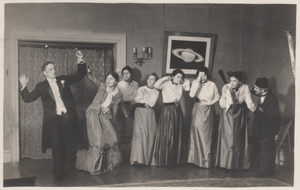
A scene in Observatory Pinafore, where Josephina stops Professor Rogers from killing himself in despair over the defection of his helpful assistant, and circle reader, and whatever else.
This image is the most widely available image of the performance.
Identifications:
Peter Millman, Cecilia Payne-Gaposchkin, Henrietta Swope, Mildred Shapley (daughter of Harlow and Martha Shapeley), Helen Sawyer-Hogg, Sylvia Mussells-Lindsay, Adelaide Ames, Leon Campbell.
These identifications come from the copy of this picture in the Emilo Segre Visual Archive. I've based some of my own identifcations on this list. This is my only source for Mildred Shapley and Sylvia Mussels, all the other faces I've found in other photos (to varying degrees of a satisfactory match, but at least enough of a match to improve my confidence that they're correct).
Use/Copyright: Copyright held by Charles Reynes, used here with permission
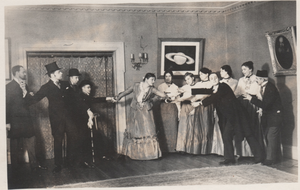
A scene from the Observatory Pinafore where Josephina is being pulled away from Professor Rogers by Seagrave and the men of Providence.
I believe this is the point in the play where Josephina is led to the "dungeon".
Identifications:
Unknown, Bart J. Bok, Unknown, Arthur Sayer, Cecilia Payne, Henrietta Swope, Mildred Shapley, Helen Sawyer, Sylvia Mussels, Adelaide Ames.
Use/Copyright: Copyright held by Charles Reynes, used here with permission

A scene from Observatory Pinfore, with Astronomers and Computers hard at work. Based on the people (and the books), this may be somewhere in the first scene of the play. If so, this could be the Winslow Upton character standing, as the right set of people are on stage for Upton's reciting of "I know the value of a kindly chorus..."
The portrait of Galileo hanging on the right still hangs in the Observatory today; it is the copy by Carlton gifted in 1890.
Identifications
Use/Copyright: Copyright held by Charles Reynes, used here with permission
 Fine's Home
Fine's Home